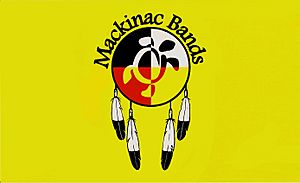Mackinac Bands of Chippewa and Ottawa Indians facts for kids
| Regions with significant populations | |
|---|---|
| United States (Michigan) | |
| Languages | |
| English, Ojibwe (Ottawa) | |
| Religion | |
| Midewiwin, Native American Church, Catholicism, Methodism, and Protestantism | |
| Related ethnic groups | |
| Other Ojibwe and Odawa, Potawatomi and other Algonquian peoples |
The Mackinac Bands of Chippewa and Ottawa Indians is a group of Ojibwe and Odawa Native Americans. They are recognized by the state of Michigan. Their main office is in St. Ignace, Mackinac County. About 4,000 people are members of this tribe.
Most tribal members live in Mackinac, Chippewa, Emmet, Cheboygan, and Presque Isle counties. However, many members also live in other parts of Michigan and across the United States.
Contents
History of the Mackinac Bands
The Mackinac Bands of Chippewa and Ottawa Indians are descendants of the Anishinaabe people. These people moved from the Northeast to the Great Lakes area, which is now Michigan, around 1200 CE. Over time, some groups settled in areas south and west of the lakes. The Odawa, Ojibwa, and Potawatomi people were closely related. They formed a strong alliance called the Council of Three Fires.
Life in L'Arbre Croche
The Mackinac Bands of these three peoples form one of Michigan's oldest and largest historical groups. Waganagisi, now known as L'Arbre Croche, was once the biggest village in the Great Lakes region. This area covered much of what is now Emmet County, including Harbor Springs and areas north of it. Odawa families lived in lodges along Little Traverse Bay around 1740.
The Odawa people of L'Arbre Croche were skilled at fishing, hunting, and farming. They grew and gathered many foods. These included corn, squash, onions, cucumbers, turnips, cabbages, melons, and wild strawberries.
Trading with the French
The Odawa traded with the French at Mackinac Island. This island was a major center for trading animal furs. It is located where Lake Huron meets Lake Michigan. The Odawa traded food, bark, and canoes. In return, they received goods like clothing, glass beads, and porcelain beads. Their canoes and food, such as dried fish, meat, and produce, were very important. They supplied the fur traders who worked in the wild areas of the Great Lakes and the Upper Mississippi regions.
Seeking Recognition
The Mackinac Bands of Odawa, Ojibwa, and Potawatomi were part of the Northern Michigan Ottawa Association. This group was formed in 1948 to help the Anishinaabe peoples in Michigan. Since then, some bands have gained official recognition from the U.S. government.
The Sault Ste. Marie Tribe of Chippewa Indians was recognized by the federal government in 1972. In 1979, their Tribal Council allowed the Mackinac Bands to become members. This almost doubled the Sault tribe's membership. However, the people who are now members of the Mackinac Bands of Chippewa and Ottawa Indians later decided to seek federal recognition on their own.
The Mackinac Bands have their own goals and issues that are different from the Sault tribe. They have been asking for federal recognition since 1998. The Mackinac Bands believe they are the rightful successors to the tribes that signed treaties with the United States. These treaties include the Treaty of Washington (1836) and the Treaty of Washington (1855).
As of 2012, the Mackinac Bands of Chippewa and Ottawa Indians have been recognized as a State Historic Tribe by Michigan. This means they receive special funding called block grants. These grants help them provide important services to their community members.
Notable Tribal Members
- Frank Dufina, an early American golf professional



